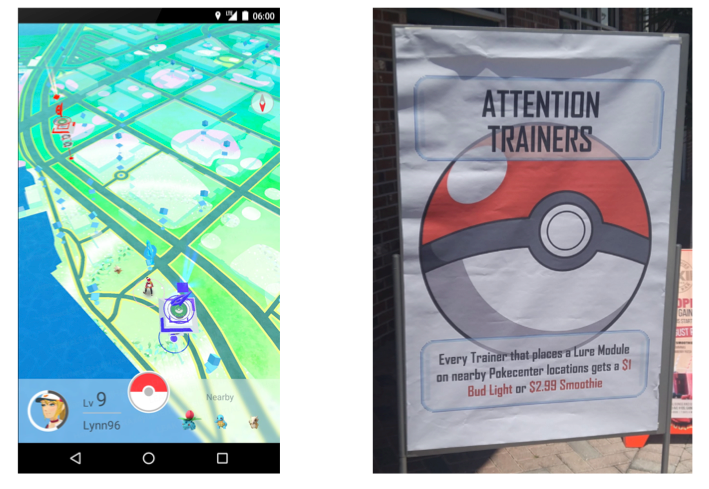For those of you who are not aware, augmented reality involves combining a user’s physical surroundings with a virtual device (most often, a smartphone or portable tablet). Strategic funding explains it clearly: “Artificial elements – viewable using a headset, glasses or a mobile device – are overlaid on the screen, incorporating them into the world around you. You can interact with this simulated environment but still be able to distinguish between it and reality.”
As an emerging marketing form, a lot of the biggest projects (think PokemonGo big) are obviously expensive endeavors, but there are several things that small businesses can do to stay on top of trends and remain active players.
The Famous Pokemon Case Study, Applied to a Small Business Model
We will start with the elephant in the room—PokemonGo is no longer the phenomenon it once was. However, it was (and still is) the most popular and profitable app of all time, so it is the ideal case study to illustrate how AI really works.
With that said, in the example above a small business used the PokemonGo craze to attract players to their café, offering discounted beer and smoothies to players that could attract even more customers to their store with “lures” (lures make more Pokemon appear in the area, and thus are desirable places for players to hang out). Genius!
While Pokemon Go seems to have fizzled out, the concept for small businesses still applies. Just because a small business cannot afford to produce the augmented reality platform themselves does not they cannot reap the benefits of their existence. In other words, the key for small businesses is to stay on top of augmented reality trends. Below explains how and where to look.
How To Stay on Top of Trends and Get Involved in Your Industry
Augmented Reality is not going anywhere, and in fact The App Solutions , referencing Juniper Research, put together the following revenue forecast that really puts its relevance into perspective:
The key to success with augmented reality for small businesses is really staying on top of trends that can be relevant to your audience. Here are some tips.
Piggy-Back off Other Popular Apps
Pay attention to new apps that are released and are gaining a lot of public attention, especially if they are relevant to your industry. If any of these utilize augmented reality, be ahead of the curve and brainstorm about how your business can benefit those app users directly. You can see some examples of apps that use augmented reality here. Take for example the app Ink Hunter, an app that lets you try tattoos on yourself, virtually, before getting one.
A small tattoo shop could easily take this existing app and offer their own artists work to be uploaded at the shop, letting users virtually try on tattoos at their storefront using images they provide. This would get customers in the door and allow them to experience a new way of “trying on” tattoos, giving them a creative and competitive edge.
Brainstorm with Social Media AI First
Social media is an increasingly important platform for augmented reality. Not only is it “the place” for user-generated content, but social media sites like Twitter, Facebook, and Instagram are among the top frequently visited sites. With video sharing, live streaming, and other forms of content sharing, augmented reality is beginning to come a daily practice for some. Take for example, Facebook adding augmented reality “masks” that people can use in their live video streams (not unlike the SnapChat craze).
As a reminder, to be considered augmented reality, the environment of the user has to interact and be somewhat altered virtually. So how might small businesses take augmented reality and social media to make something that attracts users? One way is to offer promotions or discounts for customers who live stream and creatively alter (using masks, filters, or geotags) an event you are having or using your products. Give customers credit for “checking in” to your location in a creative way.
Follow Gaming Trends
PokemonGo isn’t the only game taking a stab at augmented reality. Several AI games are being developed every day. While not all of them are going viral, some of them are definitely increasing in popularity. More impurely, more games are bound to be coming on to the scene than have opportunity for small businesses in the same way PokemonGo did.
Consider Interactive Ads with Sales and Commerce
Sales platforms (think Amazon or eBay) are among the top ways people make purchases online. As augmented reality converges with e-commerce, there are going to be several opportunities for small businesses to engage and boost their visibility and sales. Stay on top of the latest e-commerce trends, but also think about how you can boost your own sales strategy. One way to do this is with interactive ads that can creatively bridge the gap between the virtual and the physical world of the user. See some examples here.
There are so many way to become visible to your target audience online and with more people shopping online than ever before that if you can catch their attention using augmented reality, you will be able to increase engagement and sales for your brand.
Key Reasons Small Business Marketers Should Care About Augmented Reality
If you are totally convinced that augmented reality is becoming an important landscape for marketers, you may still be wondering why small business marketers should care about augmented reality. Here are the key reasons:
- Technology, especially apps and games, have the opportunity to go viral and get mass exposure. These kinds of events make the job of a marketer even easier to attract fresh and untapped prospects.
- People love personalization and to feel engaged with the technologies they use. Augmented reality offers a high level of personalization, and thus, users feel more connected with these kind personalized platforms. If your business can engage this level of personalization, you will be building relationships in no time.
- Retention and return customers are a desirable feature of every small business. When customers are more engaged they are more likely to return and be repeat customers. Augmented reality offers an opportunity for this and small businesses can really benefit from this kind of customer interaction.
The moral of the story is that while you may not be able to design a viral augmented reality game, you can still capitalize on the benefits of augmented reality and incorporate trends into your small business marketing strategy.
Do you have any experience with augmented reality for your small business? Let us know in the comments section below—we would love to hear from you!
Image Credit 1: blog.mghus.com
Image Credit 2: theappsolutions.com
Image Credit 3: techcrunch.com
Video Credit 4: businessinsider.com






